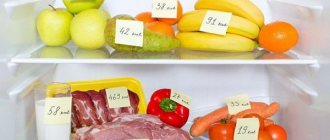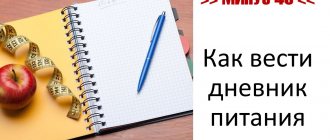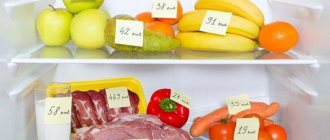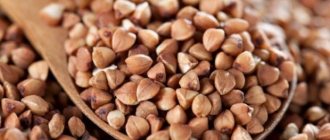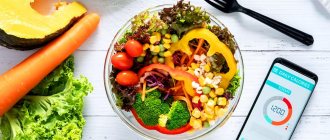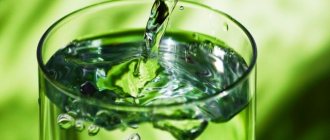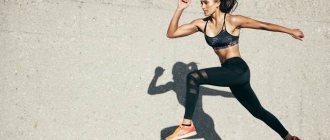Having knowledge of how to correctly count calories in the food you eat, you can easily adjust your diet in order to lose weight without harm to the body. The kilocalorie table will greatly simplify the calculation process for losing excess weight. But how should people who are losing weight count calories, and why is the system effective? This is exactly what we will talk about today.
To ensure the effectiveness of the weight loss process, nutritionists recommend counting your incoming calories so that they do not exceed energy expenditure. Each table of caloric content of products and ready-made meals includes a list of food ingredients, the energy value of which is indicated per 100 grams. After reading this article you will know:
- why and how to count calories in order to lose weight without harm to your health;
- a method for calculating individual energy needs for weight loss;
- categories with the most diet-appropriate products, each of them contains the most complete table of ingredients with KBJU;
- Are there any foods with negative calories?
- Tricks for keeping recipes low in calories.
Why do you need to count calories?
The ability to count calories is a great way to achieve any goal, be it losing weight, maintaining weight, or gaining muscle mass. If you know your calorie intake and can calculate your energy intake, you can easily create a diet for the day, including your favorite foods.
The main task of the calculations performed is to provide the body with the necessary amount of energy for the whole day. Let's take a closer look at the methods for calculating energy value and how to determine daily individual needs.
How to calculate calories in foods
At first glance, the counting procedure may look very time-consuming and tedious, but soon it will become a habit and become an integral part of the daily menu.
To do this, you will need two main tools - a kitchen scale and tables with calorie content of foods. The device can be found in any hardware store, and the necessary tables are given below. However, this is not enough to achieve the goal.
To build a high-quality form, the composition of the food consumed is extremely important. You can get your entire calorie intake from sweets, but everyone understands perfectly well that the quality of the body will not be the best. In this regard, the body must be provided with the required amount of calories, maintaining a balance in nutrients, namely: proteins, fats and carbohydrates.
Calculation of daily calorie intake for weight loss
When the goal of a diet is to lose weight, then 10-20% is subtracted from the product of basal metabolic rate and activity level, which becomes a deficit. If the initial weight is not very large, then it is recommended not to increase the deficit by more than 10-15%. When you are overweight (more than 30 kg), the deficit can be 20%, but no more!
Let's look at an example.
Parameters: woman, 30 years old, weight 65 kg, height 165 cm, training 3 times a week.
BMR = 9.99 * 65 + 6.25 * 165 - 4.92 * 30 - 161 = 1372 To maintain weight, norm: 1372 * 1.375 = 1886.5 kcal To determine the deficit, you need to subtract 15%: 1886.5 - 15 % = 1550-1650 kcal
It is 1550-1650 kcal that will be the guideline when drawing up the daily menu.
Important! It is not recommended to reduce the established calorie range, because due to insufficient amounts of important nutrients, the body will begin to slow down its metabolism, which can lead to weight gain if the calorie intake is exceeded.
How to count calories correctly to lose weight
Having decided to lose weight, you need to learn how to count the calories in the food you eat. Tables with the contents of KBZHU will be an excellent assistant in counting food items on the menu. Also don't forget:
- Be sure to take into account the energy intake from drinks. The calorie content of tea or coffee is reduced to zero, but the addition of sugar, milk, honey and other components radically changes the final figures;
- in the finished dish, the amount of calories, proteins, carbohydrates and fats is the sum of all the ingredients in the recipe;
- add KBJU oil, which is used in the cooking process.
Calorie diet
Not all people, even purely psychologically, are able to withstand a strict diet for weight loss or prepare specially separate food, and they may not have enough time or opportunity to visit the gym. But the secret to success in losing excess weight remains the same - calorie consumption should be greater than their consumption.
How to choose calorie-rich diet recipes
Many people believe that diet food is monotonous and not tasty. We can safely say that this is stereotypical thinking, based on the experience of those who either only tried to cook chicken breast and eat cucumbers, or did not try to cook according to recipes at all. In order for recipes for ready-made dishes to be low in calories, the following rules must be followed:
- choose lean varieties of meat, poultry and fish;
- give preference to low-fat dairy products;
- fry and stew food in a non-stick frying pan without vegetable or animal fat or with minimal addition;
- check the full calorie tables for foods.
Arguments of opponents of calorie counting
The stated calorie content on the labels does not correspond to reality.
Because of this, it is argued that it is impossible to accurately determine how many kcal we consume.
Food manufacturers indicate the average calorie content of their products on packages, so there is an error. In restaurants, the chef doesn't care about your figure. The caloric content of the dishes is indicated approximately.
There is a decree of the Government of the Russian Federation dated August 15, 1997 N 1036 on the provision of reliable information on the nutritional value of public catering products (link to document). This resolution obliges providers in the field of catering services to provide accurate information about calorie content, dietary supplements, vitamins and minerals in their products.
In fast food restaurants KFC, Burger King, Subway and McDonald's, information about the calorie content of menu items can be found on their website.
Despite all these inaccuracies, you can safely take information about the calorie content of products from the labels; we still have no other choice) Even if some product is constantly present in your diet and because of it you cannot lose weight, because the manufacturer has underestimated the calorie content , you can simply create a larger daily caloric deficit or increase your calorie expenditure by increasing your activity.
Not all calories are absorbed
The degree of digestion of foods affects the number of calories received.
A healthy person learns:
- Animal protein is approximately 90-95%, vegetable protein is 80-85%.
- Fats at 95-97%.
- Food rich in carbohydrates is 80-95%, depending on its fiber content.
I believe that there is no need to worry about these values. What is important to us is not exact numbers, but the relationship between the calories we count and the dynamics of weight change. If we are missing something, we can make adjustments to the overall caloric intake.
I will even say more - we all digest foods differently. But this should not worry us. Everyone counts their calories and they WILL work for your weight loss or weight gain. Did you miss something when losing weight? Never mind, just cut off another 10% of calories and continue to ignore some factor.
Despite all the errors, these figures are enough to create a diet for weight loss or weight gain.
Calorie counting apps for weight loss
Application developers offer consumers special applications for calculating KBZHU for any smartphone system. The principle of operation is almost identical everywhere and helps the user set up their diet for weight loss. Each of them has its own unique features. Here is the TOP5 selection of the most popular applications from our editors:
FatSecret - the program efficiently calculates nutritional values and calories, tracks achievements and teaches you how to create a balanced diet.
Yazio is a convenient calorie calculator that analyzes information about foods consumed and physical activity for the month.
MyFitnessPal is a high-quality development that is popular all over the world. The service is considered the best calorie counter for Android.
Diary Nutrition is a free nutrition diary with a simple interface.
Lifesum - in the program you can specify a goal (weight loss), and the application will recommend a diet in accordance with your tastes.
Which workout to choose for weight loss
In modern conditions, everyone has an almost unlimited choice of types of weight loss workouts. We recommend considering several options:
Short circuit training at home will allow you to train for weight loss without spending a lot of time.
Strength training for weight loss for men and women in the gym.
Cardio workouts for burning fat and losing weight outdoors.
Working out on an exercise bike for your buttocks will give you pleasure and help you lose weight.
Not sure which is better for burning fat: strength training or cardio? You can always start by walking to lose weight.
The essence of the diet
The principle of losing weight on a calorie diet is that during the day the body should receive fewer calories than it burns. Thus, energy will begin to be wasted from fat deposits.
This method is considered the safest, since the kilograms will disappear slowly.
“Nothing tastes better than feeling thin” Kate Moss
Negative calorie foods
Very often among people who are losing weight, you can hear about foods with a negative calorie content, for example, vegetables, which require more calories from the body than are contained in the product. In reality, everything is different.
In fact, there is really no such thing as negative calories. Any products contain proteins, fats, carbohydrates or organic acids. Vegetables and herbs, seasonings and some fruits are those ingredients whose energy value is equivalent to the body’s energy expended on their processing.
During digestion, the body spends a certain amount of energy for this work. It would be wrong to think that kilocalories from a previously eaten chocolate bar will be spent on processing, for example, grapefruit.
Proteins require the largest amount of energy expenditure of all macroelements. A 200-calorie chicken fillet eaten requires 140 kcal to process. Therefore, only 60 remain “free”. But this has nothing to do with fats and carbohydrates. For example, if you consume a spoonful of vegetable oil, it will be completely absorbed almost immediately, since the body will not need energy to process it. You can systematically eat fiber-rich foods that take a long time to digest in large quantities while losing weight and hope for a miracle, and then suffer from indigestion.
We can conclude: it is necessary to structure your diet so that it harmoniously combines all the nutrients necessary for normal human functioning.
Calorie tables for weight loss foods
While on a weight loss diet, you should avoid high-calorie foods. Below, the caloric content tables contain exactly those ingredients that can most organically fit into the diet of a person losing weight.
Cereals
Cereals are classified as complex carbohydrates, which are an excellent source of energy and an assistant in building a harmonious and healthy body. Slow carbohydrates do not cause sudden spikes in blood glucose and do not allow the feeling of hunger to occur for a long time. However, heavy consumption can lead to excess body weight. On a weight loss diet, it is recommended to give preference to cereals with a low glycemic index, namely, unprocessed products.
| Products, 100 grams | Proteins, g | Fats, g | Carbohydrates, g | Energy, kcal |
| Buckwheat groats | 12,6 | 3,3 | 57,1 | 308 |
| Buckwheat deal | 9,5 | 2,3 | 60,4 | 300 |
| Green buckwheat (“Mistral”) | 13,4 | 3 | 68 | 328 |
| Long grain unpolished rice (brown, brown) | 7,5 | 2 | 73 | 340 |
| Unpolished red rice | 7,5 | 3 | 68 | 330 |
| Wild black rice | 14,7 | 1,1 | 68,7 | 357 |
| Oatmeal | 12,3 | 6,1 | 59,5 | 342 |
| Cereals | 12,3 | 6,2 | 61,8 | 352 |
| Pearl barley | 9,3 | 1,1 | 66,9 | 315 |
| Barley grits | 10 | 1,3 | 65,4 | 313 |
| Wheat groats | 11,5 | 1,3 | 67,9 | 329 |
| Corn, food grain | 10,3 | 4,9 | 60 | 325 |
| Corn grits | 8,3 | 1,2 | 71 | 328 |
| Millet | 3,8 | 9,1 | 70 | 358 |
Legumes
Legumes are another great source of energy. On a diet, you can significantly increase your intake of complex carbohydrates and reduce calories by replacing processed grains with legumes. The fiber contained in these products quickly fills you up and contains a large amount of plant protein. You can consume any type of this product, adding it to your daily calorie intake.
| Products, 100 grams | Proteins, g | Fats, g | Carbohydrates, g | Energy, kcal |
| Pea grain | 20,5 | 2 | 49,5 | 298 |
| Whole polished peas | 22 | 2 | 57 | 330 |
| Split peas | 23 | 1,6 | 48,1 | 299 |
| Fresh green peas | 5 | 0,2 | 8,3 | 55 |
| Mash | 23,9 | 1,2 | 62,6 | 347 |
| Chickpeas | 20,5 | 4,3 | 63 | 360 |
| Soybean grain | 36,7 | 17,8 | 17,3 | 364 |
| Soya beans | 36,4 | 19,9 | 30,1 | 446 |
| Red beans, all types | 23,5 | 0,8 | 60 | 333 |
| Green beans | 2,5 | 0,3 | 3 | 23 |
| Lentils | 24,6 | 1,1 | 63,4 | 352 |
| Red lentils | 21,6 | 1,1 | 48 | 314 |
| Red split Persian lentils (Mistral) | 24,7 | 1,2 | 62,5 | 328 |
| Amaranth groats | 13,6 | 7 | 58.6 | 371 |
| Quinoa cereal | 14,1 | 6,1 | 57,2 | 368 |
Mushrooms
In addition to their rich taste, mushrooms are rich in fiber, which is extremely important for the normal functioning of the digestive tract. A small amount of calories is another advantage of the product. They contain a lot of moisture, so after drying the amount of energy value per 100 grams increases.
| Products, 100 grams | Proteins, g | Fats, g | Carbohydrates, g | Energy, kcal |
| Fresh porcini mushrooms | 3,7 | 1,7 | 1,1 | 34 |
| Dried porcini mushrooms | 30,3 | 14,3 | 9 | 286 |
| Fresh oyster mushrooms | 2,5 | 0,3 | 6,5 | 3,8 |
| Fresh milk mushrooms | 1,8 | 0,5 | 0,8 | 16 |
| Chanterelles | 1,5 | 1 | 1 | 19 |
| Honey mushrooms | 2,2 | 1,2 | 0,5 | 22 |
| boletus | 2,1 | 0,8 | 1,2 | 20 |
| Dried boletus | 23,5 | 9,2 | 14,3 | 231 |
| Boletus | 3,3 | 0,5 | 1,2 | 22 |
| Dried boletuses | 35,4 | 5,4 | 33,2 | 315 |
| Morels | 1,7 | 0,3 | 4,2 | 27 |
| Russula | 1,7 | 0,7 | 1,5 | 19 |
| Champignon | 4,3 | 1 | 0,1 | 27 |
Caviar
A huge advantage of caviar over meat is its rapid digestion. Consequently, the proteins from the component will enter the blood faster. The product is considered universal in the process of losing weight, but you should not get carried away, because... it contains a lot of salt, which will retain excess liquid, increasing the readings on the scale.
| Products, 100 grams | Proteins, g | Fats, g | Carbohydrates, g | Energy, kcal |
| Red salmon caviar | 32 | 15 | — | 263 |
| Pollock caviar, punched | 27,9 | 1,8 | 1,1 | 132 |
| Capelin caviar "Santa Bremor" | 8,1-9,3 | 36,9-38,6 | — | 365-382 |
| Herring roe | 31,6 | 10,3 | — | 222 |
| Black sturgeon caviar granular | 28,4 | 9,3 | 0,6 | 200 |
| Pressed sturgeon caviar | 38,2 | 14,5 | 1,5 | 289 |
| Pike caviar | 17,3 | 2 | — | 87 |
Sausage and sausage products
This food group cannot be classified as a healthy diet and it is better to exclude it from your menu altogether in the process of losing weight. But if it’s difficult to give up products, now you can also increasingly find natural products, but before purchasing, carefully study the composition - there should be a minimum of fat and no sugar
| Products, 100 grams | Proteins, g | Fats, g | Carbohydrates, g | Energy, kcal |
| Raw smoked loin | 10,5 | 47,4 | — | 469 |
| Selected beef REMIT cut | 12 | 5 | 1 | 97 |
| Boiled-smoked carbonade | 16 | 8 | — | 135 |
Butter, margarine, vegetable fats
Vegetable oil is rich in healthy omega-3 fats, which help keep weight under control. It is recommended to choose unrefined varieties. The benefits of animal fats are no less valuable. Preference should be given to butter and spread due to the natural composition. Margarine is made from vegetable fats and the amount of trans fats in it is extremely high, which is extremely dangerous for health. When losing weight, you should avoid various sauces, mayonnaise and oils with added sugar.
Fat consumption during weight loss is not so high, but do not forget about the importance of the presence of all nutrients in the diet. Monitor the amount of consumption of this group of products, keeping within your KBZHU norm.
| Products, 100 grams | Proteins, g | Fats, g | Carbohydrates, g | Energy, kcal |
| Butter | 0,5-1 | 78-82,5 | 0,7-0,9 | 709-748 |
| Butter "Valio" | 0,7 | 82 | 0,7 | 740 |
| Ghee | 0,2 | 99 | — | 892 |
| Olive oil | — | 99,8 | — | 898 |
| Sunflower oil | — | 99,9 | — | 899 |
| Spread | — | 40 | — | 360 |
| Walnut oil | 0 | 99.8 | 0 | 898 |
| Cacao butter | 0 | 99.9 | 0 | 899 |
| Coconut oil | 0 | 99.9 | 0 | 899 |
| Corn oil | 0 | 99.9 | 0 | 899 |
| Sesame oil | 0 | 99.9 | 0 | 899 |
| Flaxseed oil | 0 | 99.8 | 0 | 898 |
| Almond oil | 0 | 90.7 | 0 | 816 |
| Palm oil | 0 | 99.9 | 0 | 899 |
| Rapeseed oil | 0 | 100 | 0 | 884 |
Dairy
Dairy products are a unique source of protein. With their help, you can build an excellent, varied diet menu, giving preference to low-fat foods without added sugar. They also improve gut health thanks to probiotics. Cheese contains a large amount of calcium, and cottage cheese provides the body with slow-moving protein.
| Products, 100 grams | Proteins, g | Fats, g | Carbohydrates, g | Energy, kcal |
| Low-fat cow's milk 0.5% | 3 | 0,05 | 4,9 | 32 |
| Milk 1.5% fat | 3 | 1,5 | 4,8 | 45 |
| Milk 2.5% | 2,9 | 2,5 | 4,8 | 54 |
| Low-fat cottage cheese 0.6% | 18 | 0,1 | 3,3 | 85 |
| Cottage cheese 1.8% | 18 | 1,8 | 3,5 | 101 |
| Cottage cheese 5% | 16 | 5 | 3 | 121 |
| Low-fat kefir | 3 | 0,05 | 4 | 31 |
| Kefir 1% | 3 | 1 | 4 | 40 |
| Kefir 2.5% | 2,9 | 2,5 | 4 | 53 |
| Cow's milk cheese | 22,1 | 19,2 | 0,4 | 262 |
| Cheese "Adygei" | 19,8 | 19,8 | 1,5 | 264 |
| Whole milk mozzarella cheese | 22,2 | 22,3 | 2,2 | 300 |
| Whole milk ricotta cheese | 11,3 | 13 | 3 | 174 |
| Suluguni | 20,5 | 22 | 0,4 | 286 |
| Chees Feta" | 14,2 | 21,3 | 4 | 264 |
| Yogurt "Activia" | 3,8-4,5 | 2,9-3,5 | 14-15,8 | 97-107 |
| Greek yogurt | 5-7 | 3,2-6 | 3,5-4,2 | 66-100 |
Meat, poultry
Animal meat and poultry are the main source of protein in the diet of losing weight people. There is white meat, which is considered more dietary, as well as red. The absence of carbohydrates is a big plus, but in red meat you should definitely pay attention to the amount of fat before purchasing. It is recommended to give preference to the least fatty products.
| Products, 100 grams | Proteins, g | Fats, g | Carbohydrates, g | Energy, kcal |
| Beef 1 category | 18,6 | 16 | — | 218 |
| Beef category 2 | 20 | 9,8 | — | 168 |
| Beef, tenderloin | 22,2 | 7,1 | — | 158 |
| Veal 1 category | 19,7 | 2 | — | 97 |
| Pork, tenderloin | 19,4 | 7,1 | — | 142 |
| Lamb 2 categories | 19,8 | 9,6 | — | 166 |
| Beef liver | 17,9 | 3,7 | 5,3 | 127 |
| Pork liver | 18,8 | 3,8 | 4,7 | 109 |
| Beef heart | 16 | 3,5 | 2 | 96 |
| Beef kidneys | 15,2 | 2,8 | 1,9 | 86 |
| Udder | 12,3 | 13,7 | — | 173 |
| Broilers (chickens) 2 cat. | 19,7 | 11,2 | — | 180 |
| Chicken 2 cat. | 21,2 | 8,2 | — | 159 |
| Chicken breast | 23,6 | 1,9 | — | 113 |
| Chicken legs | 16,8 | 10,2 | — | 158 |
| Chicken liver | 19,1 | 6,3 | 0,6 | 136 |
| Chicken heart | 15,8 | 10,3 | 0,8 | 159 |
| Turkey, breast | 23,6 | 1,5 | — | 114 |
| Domestic goose, meat | 22,7 | 7,1 | — | 161 |
| Quail, meat and skin | 19,6 | 12 | — | 192 |
| Rabbit | 21,2 | 11 | — | 183 |
| Boar | 21,5 | 3,3 | — | 122 |
| Elk | 23 | 1,5 | — | 111 |
| Venison | 19,5 | 8,5 | — | 155 |
Vegetables and greens
Greens and vegetables are considered essential in the process of losing weight. They contain fiber, which is not absorbed by the body, and the amount of calories and dietary fat in the products is extremely insignificant. They also improve digestion and quickly saturate the body. You can eat any kind of vegetables, but the portion of potatoes needs to be controlled more carefully.
| Products, 100 grams | Proteins, g | Fats, g | Carbohydrates, g | Energy, kcal |
| Artichoke | 1,2 | 0,1 | 6 | 28 |
| Basil | 2,5 | 0,6 | 4,3 | 27 |
| Eggplant | 1,2 | 0,1 | 4,5 | 24 |
| Yam (sweet potato) | 1,6 | 0,05 | 17,1 | 86 |
| Boiled sweet potato without skin | 1,4 | 0,14 | 15,2 | 76 |
| Swede | 1,2 | 0,1 | 7,7 | 37 |
| Mustard leaf | 2,9 | 0,4 | 1,5 | 27 |
| Daikon | 1,2 | — | 4,1 | 21 |
| Ginger, raw root | 1,8 | 0,75 | 15,8 | 80 |
| Zucchini | 0,6 | 0,3 | 4,6 | 24 |
| White cabbage | 1,8 | 0,1 | 4,7 | 28 |
| Sauerkraut | 1,8 | 0,1 | 3 | 23 |
| Broccoli | 2,8 | 0,37 | 6,6 | 34 |
| Brussels sprouts | 3,4 | 0,3 | 8,9 | 43 |
| Kohlrabi cabbage | 2,8 | 0,1 | 7,9 | 44 |
| Red cabbage | 0,8 | 0,2 | 5,1 | 26 |
| Cabbage | 1,2 | 0,2 | 2 | 16 |
| Cauliflower | 2,5 | 0,3 | 4,2 | 30 |
| Kale (Kale) | 2,8 | 0,6 | 6,6 | 42 |
| Collards collard greens | 3 | 0,6 | 1,4 | 32 |
| Potato | 2 | 0,4 | 16,3 | 77 |
| Watercress | 2,3 | 0,1 | 0,8 | 11 |
| Green onion | 1,3 | 0,1 | 3,2 | 20 |
| Bulb onions | 1,4 | 0,2 | 8,2 | 41 |
| Red onion | 1,4 | 0,1 | 9,1 | 42 |
| Leek | 2 | 0,2 | 6,3 | 36 |
| Chard | 1,8 | 0,2 | 2,1 | 19 |
| Carrot | 1,3 | 0,1 | 6,9 | 35 |
| Ground cucumbers | 0,8 | 0,1 | 2,5 | 14 |
| Greenhouse cucumbers | 0,7 | 0,1 | 1,9 | 11 |
| Pickles | 0,8 | 0,1 | 1,7 | 13 |
| Squash | 0,6 | 0,1 | 4,1 | 19 |
| Sweet pepper | 1,3 | 0,1 | 4,9 | 26 |
| Parsley greens | 3,7 | 0,4 | 7,6 | 49 |
| Parsley root | 1,5 | 0,6 | 10,1 | 51 |
| Ground tomatoes | 1,1 | 0,2 | 3,8 | 24 |
| Greenhouse tomatoes | 0,9 | 0,1 | 2,9 | 17 |
| Cherry tomatoes | 0,8 | 0,1 | 2,8 | 15 |
| Salted tomatoes | 0,5 | 0,1 | 1,6-2,1 | 10-11 |
| Radish | 1,2 | 0,1 | 3,4 | 20 |
| Green radish | 2 | 0,2 | 5,6 | 32 |
| Turnip | 1,5 | 0,1 | 6,2 | 32 |
| Fresh rosemary | 3,3 | 5,9 | 17,6 | 131 |
| Arugula | 2,6 | 0,7 | 2,1 | 25 |
| Leaf lettuce | 1,5 | 0,2 | 2 | 16 |
| Beet | 1,5 | 0,1 | 8,8 | 42 |
| Celery greens | 0,9 | 0,1 | 2,1 | 13 |
| Celery root | 1,3 | 0,3 | 6,5 | 37 |
| Asparagus | 1,9 | 0,1 | 3,1 | 21 |
| Fresh thyme | 5,6 | 1,7 | 15,9 | 101 |
| Jerusalem artichoke | 2,1 | 0,1 | 12,8 | 61 |
| Pumpkin | 1 | 0,1 | 4,4 | 23 |
| Dill | 2,5 | 0,5 | 6,3 | 40 |
| Horseradish | 3,2 | 0,4 | 10,5 | 59 |
| Zucchini | 1,2 | 0,2 | 2.7 | 17 |
| Garlic | 6,5 | 0,5 | 29,9 | 149 |
| Spinach | 2,9 | 0,3 | 2 | 23 |
| Sorrel | 1,5 | 0,3 | 2,9 | 22 |
| Wakame seaweed (Undaria pinnate) raw | 3 | 0,64 | 9,3 | 45 |
| Laminaria (seaweed) raw | 1,7 | 0,56 | 8,9 | 43 |
| Dried kelp (sea kale) | 31,5 | 21,8 | 38,1 | 476 |
| Dried spirulina | 57,5 | 7,72 | 23,4 | 290 |
Nuts and dried fruits
Nuts and seeds are a balanced source of nutrition that must be present in the diet of people who care about their health and figure. They contain polyunsaturated fats, which lower “bad cholesterol” levels, control hunger and are a versatile source of protein for vegetarians.
Dried fruits are also very healthy due to their high content of micronutrients, enzymes and plant fibers. With their help, you can satisfy your sweet tooth, but in reasonable quantities. Candied dried fruits should be excluded from the menu while losing weight.
Both of these products are still quite high in calories, so it is necessary to control their consumption, fitting it into your norm.
| Products, 100 grams | Proteins, g | Fats, g | Carbohydrates, g | Energy, kcal |
| Peanut | 26,3 | 45,2 | 9,9 | 552 |
| Roasted peanuts | 26 | 52 | 13,4 | 626 |
| Brazilian nut | 14,3 | 67,1 | 4,2 | 659 |
| Walnuts | 16,2 | 60,8 | 11,1 | 656 |
| Pine nuts | 13,7 | 64,1 | 9,4 | 673 |
| Cashew | 18,5 | 48,5 | 22,5 | 600 |
| Roasted cashews | 17,5 | 42,2 | 30,5 | 572 |
| Coconut raw | 3,3 | 33,5 | 6,2 | 354 |
| Hazelnut (hazelnut) | 13 | 62,6 | 9,3 | 653 |
| Almond | 18,6 | 53,7 | 13 | 609 |
| Roasted almonds | 22,4 | 55,9 | 12,3 | 642 |
| Almond petals | 22 | 58 | 12 | 650 |
| Macadamia nut | 7,9 | 75,8 | 5,2 | 718 |
| Pecans | 9,2 | 72 | 4,3 | 691 |
| Sunflower seeds, dried kernels | 20,8 | 51,5 | 17,4 | 584 |
| Pumpkin seeds, dried kernels | 30,2 | 49,1 | 9,3 | 559 |
| Shelled hemp seeds | 31,6 | 48,7 | 4,7 | 553 |
| Unshelled hemp seeds | 20,1 | 32,5 | 14 | 429 |
| Sesame seeds | 19,4 | 48,7 | 12,2 | 565 |
| Flax seeds | 18,3 | 42,2 | 1,6 | 534 |
| Poppy seeds | 17,5 | 47,5 | 14,5 | 556 |
| Chia seeds | 16,5 | 30,7 | 7,7 | 486 |
| Raw pistachios | 20,2 | 45,3 | 16,6 | 560 |
| Roasted pistachios without oil with added salt | 21,1 | 45,8 | 17,3 | 569 |
| Hazelnuts (cultivated hazel) | 15 | 61,5 | 9,4 | 651 |
| Roasted hazelnuts | 17,8 | 66,1 | 9,4 | 703 |
| Dried bananas | 3,9 | 1,8 | 78,4 | 346 |
| Dried cherries | 1,5 | — | 73 | 290 |
| Dried pear | 2,3 | 0,6 | 62,6 | 270 |
| Dried melon | 0,7 | 0,1 | 82,2 | 341 |
| Raisin | 2,5 | 0,54 | 67,7 | 296 |
| Raisins sultanas | 2,3 | 0,5 | 65,8 | 281 |
| Dried figs | 3,1 | 0,8 | 57,9 | 257 |
| Dried apricots | 5,2 | 0,3 | 51 | 232 |
| Dried peach | 3 | 0,4 | 57,7 | 254 |
| Dried apricots | 5 | 0,4 | 53 | 242 |
| Dates | 2,5 | 0,5 | 69,2 | 292 |
| Prunes (dried plums) | 2,3 | 0,7 | 57,5 | 256 |
| Dried apples | 2,2 | 0,1 | 59 | 253 |
Fish and seafood
Fish and seafood are excellent sources of protein. The low calorie content of the product makes it ideal for weight loss. Red fish also contains omega-3. This type of polyunsaturated fatty acids has a beneficial effect on all body functions, which is especially important during weight loss.
| Products, 100 grams | Proteins, g | Fats, g | Carbohydrates, g | Energy, kcal |
| Goby | 17,5 | 2 | — | 88 |
| Pink salmon | 20,5 | 6,5 | — | 140 |
| Dorado | 18 | 3 | — | 96 |
| Catfish | 19,6 | 5,3 | — | 126 |
| Squid | 18 | 2,2 | 2 | 100 |
| Far Eastern flounder | 15,7 | 3 | — | 90 |
| crucian carp | 17,7 | 1,8 | — | 87 |
| Carp | 16 | 5,3 | — | 112 |
| Chum salmon | 19 | 5,6 | — | 127 |
| Mullet | 21 | 0,4 | — | 124 |
| Coho salmon | 21,6 | 5,9 | — | 146 |
| Baltic sprat | 14,1 | 9 | — | 137 |
| Caspian sprat | 18,5 | 13,1 | — | 192 |
| Kamchatka crab, meat | 18,2 | 1 | — | 82 |
| Shrimps | 17-22 | 0,6-1,6 | — | 80-97 |
| lobster | 18,8 | 1,3 | 0,5 | 89 |
| Bream | 17,1 | 4,1 | — | 105 |
| Lobster | 18,8 | 0,9 | 0,5 | 90 |
| Atlantic salmon (salmon) | 20 | 8,1 | — | 153 |
| Mussels | 11,5 | 2 | 3,3 | 77 |
| Pollock | 15,9 | 0,9 | — | 72 |
| Fish milk | 16 | 2,9 | — | 90 |
| Scallop | 17 | 2 | 3 | 92 |
| Navaga | 19,2 | 1,6 | — | 91 |
| Burbot | 18,8 | 0,6 | — | 81 |
| Red sockeye salmon | 20,3 | 8,4 | — | 157 |
| Sea bass | 18,2 | 3,3 | — | 103 |
| River perch | 18,5 | 0,9 | — | 82 |
| Lobster | 18,8 | 1,3 | 0,5 | 89 |
| Halibut | 18,9 | 3 | — | 103 |
| Pangasius | 15,3 | 3 | — | 89 |
| Haddock | 17,2 | 0,5 | — | 73 |
| Roach | 17,5 | 2 | — | 88 |
| Blue whiting | 18,5 | 0,9 | — | 82 |
| Crayfish | 15,5 | 1 | 1,2 | 76 |
| Carp | 18,2 | 2,7 | — | 97 |
| Atlantic herring low-fat | 19,1 | 6,5 | — | 135 |
| Pacific herring low-fat | 18 | 7 | — | 135 |
| Salmon | 21,6 | 6 | — | 140 |
| Som | 17,2 | 5,1 | — | 115 |
| Oceanic horse mackerel | 18,5 | 4,5 | — | 114 |
| Sterlet | 17 | 6,1 | — | 122 |
| Zander | 18,4 | 1,1 | — | 84 |
| tilapia | 20,1 | 1,7 | — | 96 |
| Atlantic cod | 17,8 | 0,7 | — | 82 |
| Pacific cod | 15,3 | 0,4 | — | 69 |
| Bluefin tuna | 23,3 | 4,9 | — | 144 |
| Yellowfin tuna (yellowtail) | 24,4 | 0,5 | — | 109 |
| Oyster | 9 | 2 | 4,5 | 72 |
| Trout | 19,2 | 2,1 | — | 97 |
| Sea trout | 20,5 | 4,3 | — | 157 |
| Hake | 16,6 | 2,2 | — | 86 |
| Pike | 18,4 | 1,1 | — | 84 |
| Marine language | 10,3 | 5,2 | — | 88 |
| Ide | 18,2 | 1 | — | 81 |
Sweets
In the case of sweets, everything is simple - you need to exclude products that contain sugar. If you really want something sweet, it is better to give preference to dried fruits. Also, the modern market offers a wide range of dietary products without sugar and fructose.
Before purchasing, be sure to make sure that these ingredients are not present in the composition and do not forget to enter the treat in your food diary. Self-discipline and goal-setting must come first, not allowing temptations to take over.
Fruits and berries
The amount of nutrients, antioxidants and vitamins in 100 grams of fruits and berries is colossal. These products are considered an extremely healthy delicacy, but do not forget that they contain fructose, which, when consumed in excess, can be converted into fat. Therefore, it is necessary to control the consumption of this food group during the period of weight loss.
| Products, 100 grams | Proteins, g | Fats, g | Carbohydrates, g | Energy, kcal |
| Watermelon | 0,6 | 0,1 | 5,8 | 27 |
| Apricots | 0,9 | 0,1 | 9 | 44 |
| Avocado | 2 | 14,6 | 8,5 | 160 |
| Quince | 0,6 | 0,5 | 9,6 | 48 |
| Cherry plum | 0,2 | 0,1 | 7,9 | 34 |
| A pineapple | 0,4 | 0,2 | 11,5 | 52 |
| Oranges | 0,9 | 0,2 | 8,1 | 43 |
| Cherry | 0,8 | 0,2 | 10,6 | 52 |
| Grapefruit | 0,7 | 0,2 | 6,5 | 35 |
| Pear | 0,4 | 0,3 | 10,3 | 47 |
| Melon | 0,6 | 0,3 | 7,4 | 35 |
| Fresh figs | 0,7 | 0,2 | 12 | 54 |
| Kiwi | 0,8 | 0,4 | 8,1 | 47 |
| Lemon | 0,9 | 0,1 | 3 | 34 |
| Tangerines | 0,8 | 0,2 | 7,5 | 38 |
| Nectarine | 1,1 | 0,3 | 9 | 44 |
| Papaya | 0,5 | 0,26 | 9,1 | 43 |
| Peach | 0,9 | 0,1 | 9,5 | 45 |
| Pomelo | 0,8 | 0,04 | 8,6 | 38 |
| Plum | 0,8 | 0,3 | 9,6 | 49 |
| Turn | 1,5 | 0,3 | 9,4 | 54 |
| Feijoa | 0.7 | 0.4 | 8.8 | 61 |
| Cherries | 1,1 | 0,4 | 10,6 | 52 |
| Apples | 0,4 | 0,4 | 9,8 | 47 |
| Cowberry | 0,7 | 0,5 | 8,2 | 46 |
| Blueberry | 1 | 0,5 | 6,6 | 39 |
| Blackberry | 1,5 | 0,5 | 4,4 | 34 |
| Strawberry | 0,8 | 0,4 | 7,5 | 41 |
| Cranberry | 0,5 | 0,2 | 3,7 | 28 |
| Gooseberry | 0,7 | 0,2 | 9,1 | 45 |
| Raspberries | 0,8 | 0,5 | 8,3 | 46 |
| Cloudberry | 0,8 | 0,9 | 7,4 | 40 |
| White currant | 0,5 | 0,2 | 8 | 42 |
| Red currants | 0,6 | 0,2 | 7,7 | 43 |
| Black currant | 1 | 0,4 | 7,3 | 44 |
| Blueberry | 1,1 | 0,6 | 7,6 | 44 |
Bread and bakery products
During the period of weight loss, it is better to give up the usual baked goods. There are exceptions in the form of bread made from whole grain flour and bran without sugar. Along with the product, the body will receive vitamins, minerals and dietary fiber, which have a beneficial effect on digestive processes.
Another irreplaceable ingredient in the diet of those losing weight is bread, which is also rich in fiber and vitamins. Pay attention to the composition; they should not contain sugar and fructose.
| Products, 100 grams | Proteins, g | Fats, g | Carbohydrates, g | Energy, kcal |
| Rye bread | 4,7 | 0,7 | 49,8 | 214 |
| Whole grain bread from a mixture of cereals | 13,3 | 4,2 | 43,3 | 265 |
| Dr.Körner “Seven Grains” breads | 10 | 2 | 57 | 290 |
| Dr.Körner “Borodinskie” bread | 11 | 3 | 52 | 280 |
| Dr.Körner “Buckwheat” bread with vitamins | 11,6 | 3 | 52,4 | 283 |
| Dr.Körner “Rice” crispbread with vitamins | 6 | 1 | 69 | 310 |
Flour and pasta
Pasta made from durum wheat, like cereals, is classified as complex carbohydrates, which are an excellent source of energy and an assistant in building a harmonious and healthy body. However, heavy consumption can lead to excess body weight. To prepare healthy baked goods, it is also recommended to give preference to wholemeal flour.
| Products, 100 grams | Proteins, g | Fats, g | Carbohydrates, g | Energy, kcal |
| Wheat flour 2 grades | 11,6 | 1,8 | 64,8 | 322 |
| Wheat flour | 11,5 | 2,2 | 61,5 | 312 |
| Seeded rye flour | 6,9 | 1,4 | 66,3 | 305 |
| Peeled rye flour | 8,9 | 1,7 | 61,8 | 298 |
| Rye wallpaper flour | 10,7 | 1,9 | 58,5 | 294 |
| Pasta made from premium durum flour | 11 | 1,3 | 70,5 | 338 |
| Corn flour | 8 | 1 | 75 | 340 |
| Rice flour | 7 | 0,5 | 78 | 320 |
Eggs
Eggs are one of the most versatile and affordable foods. They are part of a healthy diet and are relevant during weight loss.
| Products, 100 grams | Proteins, g | Fats, g | Carbohydrates, g | Energy, kcal |
| Chicken egg | 12,7 | 10,9 | 0,7 | 157 |
| Protein | 11,1 | — | — | 44 |
| Yolk | 16,2 | 31,2 | 1 | 354 |
| Quail egg | 11,9 | 13,1 | 0,6 | 168 |
| Goose egg | 13,9 | 13,3 | 1,4 | 185 |
| Duck egg | 13,3 | 14,5 | 0,1 | 185 |
| Melange | 12,7 | 11,5 | 0,7 | 157 |
| Egg powder | 46 | 37,3 | 4,5 | 542 |
Calculating the calorie content of the finished dish
The calorie content of the finished dish is usually indicated in the cookbook, however, not always and not everyone has the opportunity to look there. Moreover, when creating your individual menu, you will have to make several bookmarks. Therefore, it is worth talking about the general principles of calculating calories in a future dish, and how to correctly determine the calorie content of a dish.
All products change volume
During the cooking process, all products are fried or evaporated. Cereals, meat and vegetables change their volume, but their calorie content remains the same:
- Meat, poultry, and fish lose moisture during cooking and their volume decreases;
- Vegetables also lose moisture and with it decrease in volume;
- Cereals and pasta, on the contrary, absorb moisture - their volume increases.
Calorie content remains the same. For example, let's say you decide to cook chicken breast. You took 200 g of meat with a calorie content of 220 kcal, cooked it, but in the end you only got 150 g of the finished product, but its calorie content did not change - 220 kcal.
Similarly, you decided to cook buckwheat. We took 100 g of buckwheat, with a calorie content of 329 kcal, and 200 g of water. The cereal absorbed water, increased in volume, but remained with the same calorie content - 329 kcal. If you took not 200, but 300 g of water, the volume of the porridge would become even larger without changing the calorie content.
That is why, after you have counted the raw ingredients and prepared the dish, you need to weigh it and count it. Or simply calculate as a percentage how much you ate. Let's assume that you cooked 100 g of buckwheat, but only ate a third of it. To do this, you need to divide the calorie content of the finished dish by 3: 329/3 = 109.66 (rounded to 110) kcal. In this case, you don’t have to count the finished dish, since you only ate a third of it. There is no need to recalculate the calorie content of a finished dish that you are going to eat in its entirety. Just count its raw ingredients.
Calculation of calorie content of a complex dish
If it’s easy to cook porridge and cook meat, then what about complex dishes that are prepared for the whole family? Let's look at simple examples.
Calorie calculation of cutlets
Let's say you decide to make cutlets, beloved by your household, for this you will need:
- 1 egg – 86.35 kcal;
- 0.5 kg of beef – 935.0 kcal;
- 100 g of milk – 64.0 kcal;
- 100 g of white bread – 242 kcal;
- 20 g of garlic – 28.6 kcal;
- 50 g of onion – 20.5 kcal;
- 100 g of vegetable oil – 899 kcal.
Total calories: 2275.45 kcal.
Total raw weight of products: 925 g.
We calculated the calorie content of the amount of food we needed. To do this, we used the Calorie Table and Recipe Analyzer on our website. Now you can start preparing the cutlets themselves.
All cutlets will be 2272.45 calories. To find out how many calories are in 1 cutlet, you simply need to divide the total calories by the number of cooked cutlets. However, if the size of the cutlets is different, then this method of calculation is not the most suitable.
More precisely, calculate the calorie content and nutritional value per 100 grams of the finished product. To do this, do not eat cutlets until you have done all the calculations. So, after the cutlets are cooked, see if there is any oil left. If there is oil left, measure its volume using a measuring container (get used to using this container), and subtract the calorie content of the remaining oil from the total.
Let's say you have no butter left at all, the weight of the cutlets is 700 g. Now you need to calculate how many calories are contained in 100 grams of your cutlets. To do this, we divide the total calories by the weight of all the cutlets in their finished form.
Let's use the formula:
Calories of all raw ingredients / weight of the finished dish = calories per gram of the finished dish
Calorie content 1 gram x 100 = calorie content 100 g of finished dish
It turns out 2275.45 / 700 = 3.25. This is exactly how many calories are contained in one gram of ready-made food. And 100 grams of cutlets contain 325 kcal. The calculation is ready. Add your product to the calorizer database. Next time you cook, use the same amount of ingredients so you don’t have to count everything again. All that remains is to weigh 1 cutlet and write it down in your diary.
Calculation of calorie content of soup
You can also calculate the calorie content of a serving of soup. To do this, you need to weigh all the raw vegetables and then calculate the calorie content of each of them, which can also be found in our Calorie Table.
Then the total volume of the cooked soup is measured, since the water usually boils away during cooking, and then, some people like their soup thicker, while others prefer it thinner. The total calorie content of all products is divided by the resulting volume of the prepared soup, this figure is then multiplied by 100. This way we can calculate the calorie content of 100 ml of the resulting soup.
Formula:
Calories of all raw ingredients / volume of finished soup = calories of 1 ml of soup
Calorie content 1 ml x 100 = calorie content 100 ml of soup.
Calculation of calorie content of a side dish
The calorie content of a serving of pasta is calculated by bookmark, in other words, cooked pasta has the same nutritional value as raw pasta. It is the volume that changes, not the calorie content of the overall dish. But the calorie content of a dish per 100 grams varies.
To find out the caloric content of a serving of a simple dish, divide the number of calories by the portion eaten:
We prepared 100 grams of pasta and ate half.
Calorie content of pasta / 2 = calorie content of the eaten portion.
If you need to calculate the calorie content of mashed potatoes, take into account the calorie content and weight of potatoes, butter, milk, as well as the weight and volume of products. Let's say you have cooked 0.5 kg of potatoes (this is the weight of the finished potato), you added 100 ml of milk and 20 g of butter to it. Thus, the total weight is 620 g.
Now you can look at the calorie content of foods in the tables, and then make a calculation. To do this, you need to divide the total calorie content by the resulting weight, so you will know how many calories are in one gram of puree. We multiply the resulting figure by 100 and get the calorie content of a serving of mashed potatoes equal to 100 grams. It’s simple, the main thing is not to forget to write down the data in your Personal Account if you need to access it in the future.
Two mistakes when calculating calories
It is very easy to make mistakes when calculating the calorie content of dishes. A typical mistake most people make is focusing on the weight of cooked dishes. The calorizer database in your Personal Account contains a huge number of recipes, but you never know exactly what ingredients a particular dish is made from. When choosing “porridge with milk”, you don’t know how much milk the author of the recipe added to it. When choosing a “vegetable salad with butter,” you won’t even guess what vegetables are in it and how much oil it contains. Likewise, when choosing simple “buckwheat on water”, you cannot know in what amount of water it was cooked. The calorie content of these dishes is good if you have a snack somewhere, but do not know how to write down the calorie content in your diary. In this case, you can safely use the calorie content of ready-made dishes.
Always calculate the weight of dry (pasta, cereals, flour) and raw (vegetables, meat, fish) products, and use ready-made dishes only from the database of your own recipes, provided that each time you take the same amount of ingredients to prepare them.
The second mistake is to have a prepared snack. For an accurate calculation, you first weigh the raw ingredients, and then the finished dish. If you start snacking ahead of time, eat a cutlet or a bowl of soup “to try” or out of boredom, then you will not be able to accurately calculate its calorie content and risk overeating.
Show willpower, understand that if you have done all these calculations, then you need it. The food won’t run away from you, eat it later when it’s ready. But you will know exactly the calorie content of the dish and your portion.
So, today you learned from our article how to correctly calculate the calorie content of a finished dish. We gave cutlets, soup, pasta, and mashed potatoes as examples. We hope you can now easily calculate the calorie content of any dishes!
Author: Zhanna Sh. (especially for) Copying this article in whole or in part is prohibited.
Calorie table for drinks
Various types of drinks are present on the menu of any person every day. And this is where many make mistakes in calorie counting, because they do not take into account the calorie content of, for example, a latte, but milk is added to it, which has a certain energy value. Adding sugar also significantly increases the calorie content of the drink.
Alcoholic drinks
Alcohol blocks the process of breaking down protein into amino acids, which reduces the level of fat burning. Alcohol also removes fluid from the body, which interferes with the process of protein absorption, neutralizing any goal pursued by a person. Therefore, during the period of weight loss, you should avoid such drinks.
